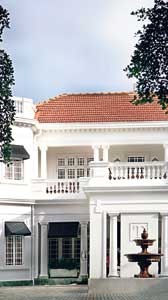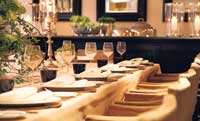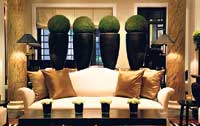
Timeless TintagelIt is not President’s House or Temple Trees but No. 65, Rosmead Place has seen as much history unfold within its halls as these stately mansions. For decades, ‘Tintagel’ was the base from where members of the Bandaranaike family chartered the fortunes, sometimes good, sometimes bad, of the country. The imposing façade remains unchanged but today as we walk through its doors, the Bandaranaike family home has been transformed. As ‘Paradise Road Tintagel Colombo’, the property is now being promoted as ‘a unique private hotel’.
It was in early 2005 that Shanth Fernando, entrepreneur, restaurateur and design guru, a close friend of Sunethra Bandaranaike happened to visit Tintagel when it was on the verge of being leased to a foreign mission. With his inherent conviction that in life when opportunity knocks, it should be taken, Shanth was quick to make an offer himself, adding Tintagel to the list of vintage properties he has acquired. Contrary to general perception, Tintagel was not built for the Bandaranaikes, but for a well-known Gynaecologist of the last century Dr. Lucien de Zilwa who designed it himself with Parsee architect Homi Bilimoria in 1929. The de Zilwa family lived there for more than a decade, till 1942. During the Second World War the house was commandeered virtually overnight for the use of British troops and returned somewhat battle-scarred after. Disheartened by the ruin of his beautiful home, its tennis courts destroyed and teak floorboards damaged, Dr. de Zilwa decided to dispose of it below cost to Sir Solomon Bandaranaike for Rs. 160,000. It was for his Oxford educated son SWRD, an ambitious young politician and his family then living in Lionel Wendt’s house ‘Wentworth’ at Guildford Crescent. In Bandaranaike hands for more than five decades, the house witnessed both tragedies and triumphs. It was on its white marble verandah that SWRD, by the time Prime Minister of Ceylon was shot in 1959, the first Lankan leader to die of an assassin’s bullet. It was also from Tintagel that his widow Sirimavo left to make the trip to Temple Trees to be sworn in as the country’s first woman premier and indeed the world’s first. Son Anura was born at Tintagel while elder daughters Sunethra and Chandrika grew up here. Later, adding one more significant chapter to the family’s political history, Chandrika Kumaratunga was to become the first woman President of Sri Lanka. Shanth Fernando was mindful of the history that accompanied the house, though not completely overawed by it. “The biggest challenge for me was to take a house as important as this, a national treasure and convert it into what I have done,” he says. “I got only the shell, no furniture came with it.” For him, creating Tintagel the hotel, has been a labour of love, which he has worked on, every day for the past two and a half years, “growing with the building”. Yet he has chosen not to make it a monument or museum to the illustrious family….there are no family portraits, no memorabilia to be seen. Huge gates shield Paradise Road Tintagel from the curious gaze of passersby. The sweeping drive has been entirely paved with a large fountain taking centre stage. As you step onto the threshold, two huge urns stand sentinel by the doorway.
Inside the heavy glass doors emblazoned with a T., the effect is a stark contrast to the colonial feel that characterized the house in Bandaranaike days. While structural changes within have been discreetly done and the stately columns and wooden flooring left intact, the furnishings are now in classic Paradise Road style. His vision for Tintagel, Shanth says, was not to create another colonial style interior. Tasteful, timeless, style was his credo. “I like the feeling of timelessness,” he explains. A historical building, but one in today’s style is more what he envisioned. “I wanted a look that was totally different…that could be on par with what you would see anywhere in the world.” The style is eclectic. Huge vases dominate the main corridor running through the house from the doorway, obscuring the view of the pool where at the far end life-sized sculptures of male nudes look down on the water. The individual touches are all Shanth, drawn from his extensive travels across the world. In the reception area tucked to a side are engravings of several coats of arms of countries across the world. A Flemish chandelier graces the main hall, in the bar hangs an ornate mirror from a chateau in Marseilles,upstairs traditional wee-malu weaves adorn the landing creating yet another focal point as are the Chinese cabinets and Burmese reliquaries found in the bedrooms. The carpets were all handwoven to his design, in Nepal. The trademark Paradise Road stripes are everywhere, the ten suites (Superior, Executive and Junior) in particular unfolding in stripey walls and coverings in two-toned combinations of colour - ebony and ivory, avocado and chocolate, mud and ebony etc. The result is sleekly elegant. The four-poster beds are again Shanth’s own design and comfort is uppermost in the plump feather and down quilts, the Egyptian cotton sheets. The mod cons are present too- flat screen TVs, Bose music systems and mini Jacuzzis in the bathrooms. Space has been maximized with architect Philip Weeraratne’s expertise. “The Bandaranaike kitchens have become the most luxurious suite,” Shanth smiles, adding that his leanings towards feng shui influenced this and many other changes in the house. The library, a feature in the old house with some 6,000 books now has a collection of 500 leather-bound volumes, handpicked by him, again an eclectic mix, ranging from Jane Eyre to books on his pet subjects of architecture, travel and Buddhism. As an avid art collector, Shanth has drawn on his extensive personal collection to give Tintagel’s walls the kind of ambience not easily duplicated by other decorators. While paintings by some of his local protégés, promising young artists like Prageeth Ratnayake and Sameera Kalupahana find prominence, there are many little seen Lionel Wendt photographs and works by Saskia Pringiers to delight the discerning. The private dining room upstairs which can seat upto 30 is virtually a Wendt Gallery in itself. While there is no vast garden space, The Court Yard on one side offers opportunities for al-fresco dining under garden umbrellas, with a sprawling Thumbergia creeper affording effective cover, cascading white blossoms against a curtain of green. Inside, the main dining area where non-resident guests can make a booking, is all muted elegance - grey silk panels on the walls and dusky burgundy glassware, again custom-made for Tintagel. Deep within the inner recesses of the mansion are the gym and the kitchens, well equipped with cold room, butchery and bakery, new and necessary additions for Tintagel, the hotel. In a sense, Paradise Road Tintagel marks a return to Shanth’s early beginnings in the hotel trade when as a 20-year-old he was running his sister’s guest house. He set up his own in Mount Lavinia soon after and remembers going mad with colour, decorating blithely with Barbara Sansoni fabrics, Ena de Silva batiks and Bawa’s Barcelona chairs. Then going abroad to study hoteliering, he worked in Amsterdam, New Zealand and Sydney before returning to Sri Lanka and launching the Paradise Road lifestyle stores with crafts made to his own design by local craftsmen. Taking his passion a step further, he acquired Fincastle, an old house earmarked for demolition on Dharmapala Mawatha which he converted to his Paradise Road store, and later, legendary architect Geoffrey Bawa’s office down Alfred House Gardens which became his flagship Paradise Road Gallery café. Tintagel, then comes as the ultimate achievement. He is positive that it has been the biggest challenge of his life, one he has done ‘my way’. And in Shanth’s book, challenges are a blessing. |
|| Front
Page | News | Editorial | Columns | Sports | Plus | Financial
Times | International | Mirror | TV
Times | Funday
Times || |
| |
Reproduction of articles permitted when used without any alterations to contents and the source. |
© Copyright
2007 | Wijeya
Newspapers Ltd.Colombo. Sri Lanka. All Rights Reserved. |


